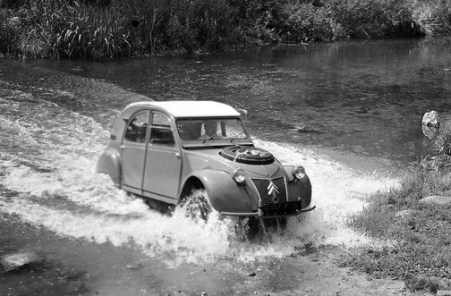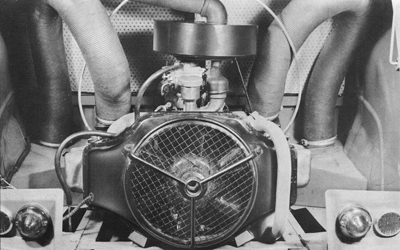Citroën 2CV Sahara: 2CV and 2 Engines
- COCKPIT
- Apr 6, 2024
- 5 min read
Everyone knows “deudeuche” and its countless variations. On the other hand, there is a version which is out of the ordinary and which vibrates wallets to such an extent that the last sale of this model left a collector for 172,800 euros during an Arcurial auction in 2016, enough set a new sales price record for a 2CV.
But what does this Citroën have to panic all passions?
Well, we're going to tell you his story.


The beginning of the history of Citroën
Let's start with a little history, with the beginning of Automobiles Citroën in 1919 when André Citroën transformed his shell factory into a car factory. It immediately began its first collaboration with Michelin for the supply of its tires. Citroën is inspired by Fordism, a model of business organization and development developed and implemented in 1908 by Henry Ford. André Citroën also has a great sense of marketing. He did not hesitate to use all the modern means of his time to make Citroën known: in 1922, a plane wrote the name of Citroën in the sky at the opening of the Paris auto show, in 1925, for the Decorative Arts exhibition from Paris, he dressed the Eiffel Tower with the name of his brand, which shined above the roofs for almost ten years. He also invented Citroën caravans. The Citroën brand then became renowned for its futuristic technologies and, on several occasions, it revolutionized the world of the automobile industry. Citroën has notably created, throughout its history, several avant-garde creations including the Traction Avant, the utility H, DS, Méhari, SM, GS, CX, BX, XM, but it is the 2CV which stands out the most spirits.
Despite all these innovations, Citroën went bankrupt in 1935, and the Michelin company took control, it was the beginning of a new era for Citroën and also the beginning of the myth of the CV.

The birth of the 2CV
The 2cv was born on the day of a meeting in 1935 during which Pierre Michelin launched the study of a new model. According to Édouard Michelin, then big boss of Michelin and, by derivation, of Citroën, and his right-hand man Pierre Boulanger, decided to create a new type of car, the TPV (Toute Petite Voiture), it must be reliable, inexpensive and with low maintenance within the reach of all budgets.
It must be able to be driven by peasants in clogs and be able to sleep outside, in the fields, in winter and then start again like clockwork in the morning.

According to requirements in terms of comfort but also the ability to move on roads generally in poor condition at the time, the future car must have very flexible suspension. For example, she must be able to cross a plowed field with a basket of eggs in the trunk without breaking a single one.
Initially two hundred 2CVs were to be presented at the 1939 Auto Show, an objective which was not achieved; we had to wait until the 1948 Paris Motor Show following the hazards linked to the Second World War (the Germans wanting to appropriate the plans of the 2CV in exchange for those of the Käfer 'Beetle' from VW, something that the directors of Citroën refused, the Germans then bombed the Citroën factory at Quai de Javel) so that Citroën could finally present the 2 CV type A.

Thus, the machine to create myths is in place, several limited series are marketed or not, including the best known: the 2CV6 Charleston, the 2 CV Cocorico and again the 2CV 007.
Alongside them, Citroën produced special models, one of which particularly caught our attention: the 2CV Sahara, and for good reason, it is the only production car with . . . 2 engines.
The 2CV Sahara has 2 Engines!
Special model, special features!
For a 2CV to be truly special, it needs 2 engines.
The idea of creating a dedeuche with unsuspected crossing qualities originally came from a dealer who presented the idea to the management of Citroën who quickly saw in it the potential to be the future Jeep which would serve the oil exploitation in the Algerian Sahara. The idea is implemented and is a small technical feat, because if powered by 2 engines on a 2CV seems to be a fairly simple technical solution given the symmetry of the chassis, it is necessary to be able to install the second engine/box group in returned and place it in the rear trunk. The second engine is autonomous with its own starter, dynamo, regulator and ignition key.

All controls are doubled: the accelerator pedal acts on the two carburetors, that of the clutch separates each of the two boxes from its engine. The gear lever acts on two linkages which can be separated for use in two-wheel drive. The cockpit has two ignition keys. The assembly includes two dynamos, one on each motor, and two voltage regulators. Even if each of the dynamos is capable of fully recharging the accumulator battery, it is recommended, but not required, to use both engines for optimum vehicle performance and to maintain the same wear rate. Thus, there is no differential between trains. This poses no problem on soft ground, with very satisfactory behavior, but considerably reduces the efficiency of the transmission on sticky ground, with one engine always lagging a little behind the other. Despite the space occupied by the second engine, the car can still accommodate 4 people, only the space reserved for luggage and the spare wheel have disappeared! Equipped with low pressure tires, the Sahara is effective on all terrains. Given the absence of a differential, the car tends to slip on hard ground. This is the configuration of the prototype unveiled in March 1958 in the sands of Ermenonville. The Sahara made its official debut at the 1958 Paris Motor Show with a few improvements making it more usable: a spare wheel was placed on the hood, the rear engine fairing was redesigned, vents were added and the rear fenders were cut out.
This is how it will appear in the 1959 catalog. It will undergo few modifications during its career: In 1960, two fuel filling ports appear in the doors, supplying the two small tanks placed under the front seats. In 1962, Algeria was no longer French and the 2CV lost its name "Sahara", for obvious geopolitical reasons, and took the name 2CV 4X4. It also sees its power increase from 24hp to 28hp. The 2CV 4X4 is sold in France at a price of 9,830 francs. It existed until 1967, but sales having become confidential, it disappeared during the summer. Its deafening noise, the absence of a safe and its double consumption limited its use to places difficult to access perhaps explains why only 693 copies found a buyer. Its selling price, more than double that of the base sedan, certainly did not favor mass production. Administratively speaking, 2 x 425cc, or 850cc, made it a 5hp tax, which amused those who thought that 2x2 made 4!









































